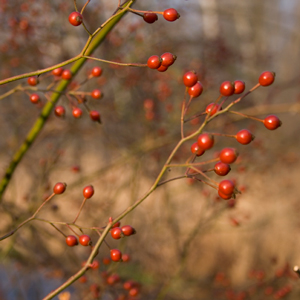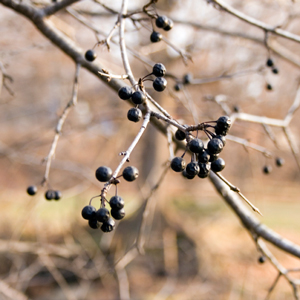What To Do in the Garden in November & December

Multiflora rose
The deciduous trees have lost their leaves, gardens are being put to bed, and winter is not far behind.
Adding a few inches of shredded leaves or compost to your garden beds before the ground freezes will aid in your garden’s health providing better soil structure and more nutrients. Incorporate the organic matter into the vegetable garden now or wait until spring to work it into the beds.
Reduce the possibility of pest problems this winter by raking fallen leaves away from the foundation of the house, making it less desirable for mice to take up residence there or find their way inside your home through small openings.
Now that the outdoor garden chores are done, keep garden tools at peak performance. Clean, oil, repair broken handles and sharpen blades. After sharpening or removing rust be sure to wipe tools with mineral oil to keep it at bay.
There’s nothing like bringing in the outdoors for the holidays. Now’s the time to gather grape vine, pine cones, wild rose hips, seedpods, twigs, winterberries, dried flower heads, and more. You can use them au naturel or spray paint seedpods, flower heads, pine cones, etc., to add color and glitz to your arrangements and wreaths.

Black chokeberry (Aronia
melanocarpa)
Some annuals are happy overwintering in pots. Great choices are geraniums, gerbera daisies and Coleus, to name a few. Place in a sunny window or under artificial lighting and water when dry. You may need to pinch back growth if they get leggy and do remove any yellowing leaves. Fertilize lightly with a liquid fertilizer once a month. The flowering plants will brighten up your winter with colorful blooms.
Enjoy using fresh culinary herbs (such as basil, thyme, parsley, oregano, rosemary, etc.) in your cooking during the holiday and winter season. Transplant from the outside into 4- to 6- inch pots or purchase from a garden center. Place on a sunny windowsill or under grow lights.
Add blooming fragrance to a home and/or office this winter with paperwhites. You can find them in local garden centers or purchase them through catalogs. They look nice nestled among decorative stones in a shallow container. Place bulbs with their points facing up and make sure to keep them watered. Plant in early November to have blooms 6 weeks later.
Cutting pine, fir and spruce boughs to decorate your home for the holidays adds fragrance and color to mantels and centerpieces. Keep in mind that not all evergreens are created equal. Consider using white pine, Fraser fir, cedar, or juniper, to name a few. Remember that cut boughs mean running sap that can damage clothes and furniture, so be aware. Homes that burn wood or have fireplaces will tend to dry fresh greens more quickly, so keep them away from heat sources.
In New York State, Christmas trees are divided into two main groups: the short-needled spruces and firs and the long-needled pines. The ideal Christmas tree has good needle-holding ability, attractive color, a full or bushy appearance, a conical symmetrical shape, a pleasing fragrance, and branches sturdy enough to hold ornaments and gifts. Make sure to purchase a fresh tree and keep it watered. Spruces tend to drop their needles readily when they eventually dry out, while firs and pines often hold onto their needles.
Poinsettias add color and freshness to your holiday décor. Unfortunately, these plants have gotten a bad rap about being poisonous if eaten. The truth is they are nontoxic and will only cause an upset stomach if eaten but it is still a good idea to keep them away from chewing pets and toddlers. If you have cats that love to chew your plants, then you may want to skip the poinsettias altogether.
Wow your holiday guests with simple but elegant table displays. Fill sparkling glass containers one-third of the way with water, float fresh cranberries, and add sprigs of winter berries, wild rose hips, pine, spruce, boxwood, juniper or any evergreen available. Consider larger, lower containers to add a large burning candle to the center.
Spruce up your holiday banquet table by adding depth and natural decor. Use rocks with a flat surface, small slabs of cut wood, or anything you can use on top or under your table covering to add depth. Add a variety of evergreen sprigs, berries, seed pods, and dried flower heads to give your buffet an alfresco air. Use elevated sections to hold hot or cold dishes, add string of twinkle lights intertwined and voila!
Consider adding warmth and freshness indoors with a terrarium of succulents. Using a large glass Container, layer the bottom with colorful stones for a drainage area, add a nice layer of soil and then a variety of succulents now readily available at your local stores and garden centers.
It’s best not to add a lid as succulents tend to enjoy it a bit drier—think more desert-like, where they depend on moisture from the soil, not the air. Add interest by robbing your fairy garden stash of gnomes and other tiny garden figures.
—Holly Wise, horticulturalist, and Linda Wimmer, Master Gardener, Cornell Cooperative Extension of Oneida County
Views: 0




